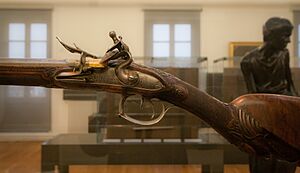Fusil de chasse facts for kids
The Fusil de chasse (say "foo-zee duh shass") was a special type of French hunting gun. It was a light smoothbore flintlock musket. This means it had a smooth barrel and used a flint to make a spark and fire. The name "Fusil de chasse" means "gun of the hunt" in French.
These guns were known for being very elegant. They had a unique "cow's foot" shape on the buttstock. This shape helped to reduce the gun's recoil (the kickback when it fires). Many of these fusils were made at the Tulle arms factory in France.
The Fusil de chasse was similar to the Charleville musket, another French gun. However, fusils were usually lighter and shorter. The word "fusil" is pronounced "fusee" in English. The French word "fusil" comes from the Italian word fucile, which means flint. Both the French and British armies had versions of an officer's fusil. The British ones were based on their Brown Bess musket. The word "fusilier" (a type of soldier) also comes from "fusil."
A cheaper version of this gun was called the fusil de traite (trade gun). Officer's fusils were much better made. They had a strap for carrying and a shorter stock to fit a bayonet. The fusil was also used for hunting birds, like an early shotgun. These guns were very common in 18th century Colonial America. Americans used them during the American Revolution.
Contents
History of the Fusil
Early French Gun Making
In France, making weapons became a big industry around 1535 in Saint-Étienne. The first official gun factory, called an armory, opened there in 1669. Nearby, in Tulle, gun making started around 1646. Tulle also got its own armory in 1690.
France started using the flintlock system for its armies in 1630. Both Tulle and Saint-Étienne made flintlock guns for French soldiers in America. Around 1690, a typical musket was about 60 inches long. Its barrel was about 44 inches long.
Standardizing Muskets
Before 1718, army captains made sure their soldiers had working guns. But soldiers could often choose their own musket. This meant different guns were used in the same company or army. This was a common problem for armies back then.
Things changed with the Model 1717 fusil. This gun made muskets and ammunition standard for the French army. It was longer than British muskets at the time. This gave French troops an advantage. At 63 inches long with a 47-inch barrel, it allowed soldiers to fire from three rows at once. With a bayonet, it was even longer.
The Model 1717 also had a front sight to help aim. This made it a bit more accurate than British muskets.
Improvements Over Time
Some small improvements were made with the M1728 model. But it was mostly the same gun. More important changes came in 1746. The wood ramrod (used to load the gun) was replaced with a metal one. French muskets fired bullets that were about .69 caliber in size.
A fourth model came out in 1754. This version was shorter and lighter for officers. The officer's model weighed about 7 pounds and was 54 inches long. All officers, even generals, carried this officer's fusil. These guns were used during the French and Indian War. Many were also used by Americans during the American Revolution.
Hunting Fusils
The fusil de chasse was made for hunting. While many muskets from Tulle followed specific models, some hunting fusils were custom-made. Their design depended on their purpose and who would buy them.
In 1695 and 1696, contracts from the Tulle factory asked for "five hunting muskets for the Indian Chiefs." These special guns were later called a Fusil fin (chief's grade musket). They were about .56 caliber and 45 inches long. They were "well filed and well polished with fine mountings and a flat lock." These elegant hunting muskets were given as gifts to Native American chiefs.
The Fusil de Traite (Trade Gun)
In New France (French lands in North America), Native Americans allied with the French often carried French fusils. These were either Fusils de chasse or fusils de traite.
At the Battle of the Monongahela in July 1755, British General Edward Braddock was ambushed. Native American and French troops attacked him. General Braddock was likely killed by a .62 caliber ball from a French fusil. Most Native American warriors at the Monongahela River carried the smoothbore Tulle musket.
Native warriors took great care of their muskets. They strongly preferred French fusils over guns made elsewhere. The fusil de traite was designed as a cheaper trade gun. However, many Native Americans knew the difference and preferred the better fusil de chasse.
Many different fusil models were sent to the Americas. The light fusil de chasse was perfect for people who hunted for a living. So many were needed that the factory in Saint-Étienne had to help meet the demand. Most of these guns were sent to New France. Here, trading was very important between Native Americans and the French.
Both types of fusils (de chasse and de traite) were made with either iron or brass parts. Most were .62 caliber. Both were marked "Tulle" (or "Tvlle" in older spelling) on the lock plate. This makes it hard for archaeologists to tell them apart today. Many modern copies of these guns are also marked "Tulle."
Cost of Fusils in 1750
Here's what different flintlock guns from Tulle cost in 1750:
- Fusil de Chasse (regular hunting gun) - 15 to 20 livre. This would be about $30 to $40 in 1997 US dollars.
- Fusil de fin (chief's grade) - 25 to 40 livre. This was about $50 to $80 in 1997 dollars.
- Fusil de traite (regular trade gun) - 9 to 15 livre. This was about $18 to $30 in 1997.
- Fusil de militarie (soldier's gun) - 20 to 30 livre. This was about $40 to $60 in 1997 US dollars.


